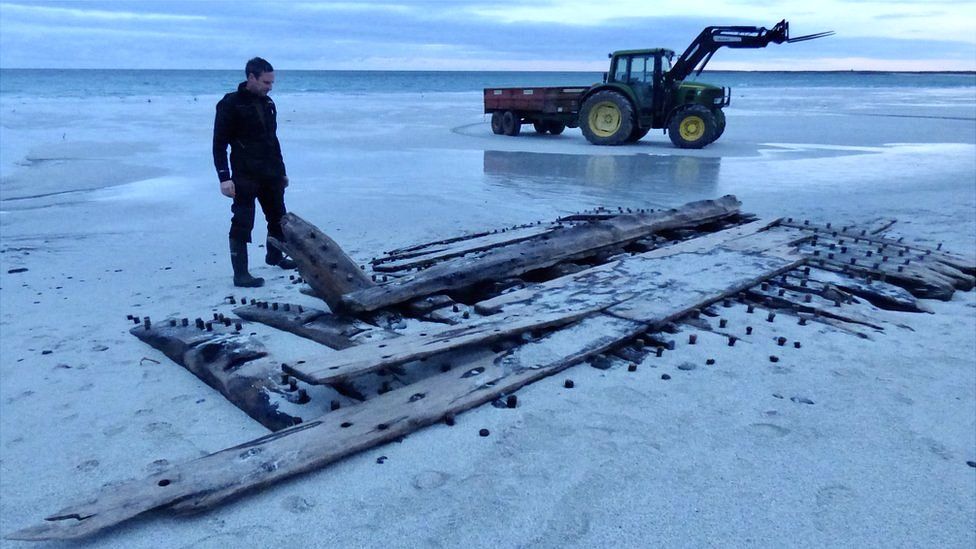Old shipwreck begins to break up on Orkney beach
- Published

The wreckage of an old wooden ship which was discovered on an Orkney beach is beginning to break up.
Attempts to rescue the separated pieces began on Sanday on Monday afternoon.
It is thought a recent storm released the well-preserved wreck of the vessel - which could date from the 1700s - from beneath the sand.
Edinburgh-based archaeologists will arrive at the end of the week to record and sample the parts of the ship that have been saved.
The wreckage that was discovered had its timbers held together with large wooden pegs in a style understood to have been commonly used as far back as the 16th Century.
It is hoped the timber can be preserved and that further investigation will reveal more about the ship.
Roderick Thorne, from the Sanday Heritage Group, said: "The wreckage started breaking up the weekend."
He said that on Monday evening, farmer Raymond Brown, from Colligarth, used his tractor to remove two large sections from the beach.
"They'd become detached from the main wreckage, and we are now keeping them wrapped up and damp with brine so they can be analysed by the archaeologists when they arrive in Sanday on Thursday," Mr Thorne said.
"We have removed one ship's timber around 4m (13ft) long, and two 'futtocks' around 2m (6.5ft) long from the beach. The rest of the structure is still pretty intact on the shore but it's too heavy to attempt to move the whole thing."
Orkney Islands Council received emergency funding from Historic Environment Scotland for an archaeological team from Wessex Archaeology to visit Sanday on Thursday and Friday.
They will survey the wreckage and take samples to analyse and date the ship's timbers using dendrochronology. These will provide information about how old the vessel is and where it was built.
The archaeologists are also offering to train Sanday residents in how to survey and preserve any future marine wreckage found on the island's extensive sandy shoreline.
Ben Saunders from Wessex Archaeology said they had wanted to first assess the layout of the wreck in case it had been damaged while it was being moved, but the wreckage had shifted down the tideline.
"I still don't really think it has been washed up, I think it has been in that bit of the beach for a while and the sediment around it has exposed it," he said.
"We felt at the time that it was looking like it was going to get reburied, which would have been the best thing for it - it would have kept it safe and preserved it until potentially further work could be done."
He added: "It's hit the point where it's obviously starting to break up so it is necessary to get it up the beach at least for now to get the recording done and sampled.
"Conserving and preserving this sort of material is very difficult and very expensive so the more suitable option is preservation by record."
Records include photographs, drawings and getting as much data as possible from a wreck in a short space of time.
Mr Saunders said people on Sanday had done "fantastic" work recording details of the wreckage and their photography could be used to recreate a 3D model of the wreckage.
His team hopes to take slices out of the timbers to do tree-ring dating and potentially work out where the trees grew.
Sanday author and historian Myra Stockton has catalogued about 200 shipwrecks around the island, dating as far back as 1596.
She said records identified 14 ships lost near the beach where the wreckage found and there was local speculation that the latest discovery could be part of the Spanish Armada.